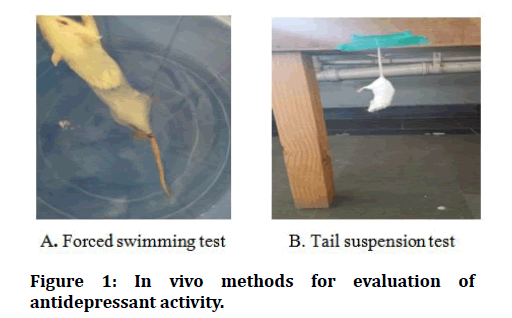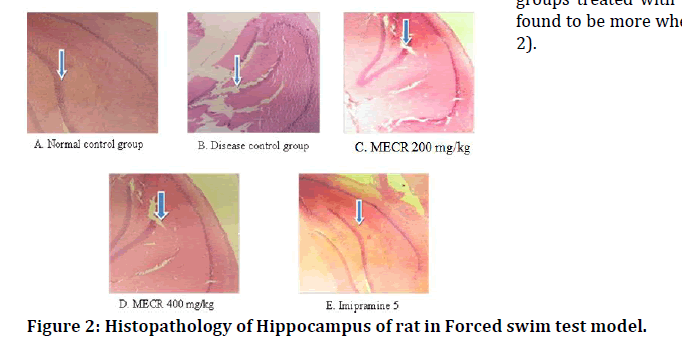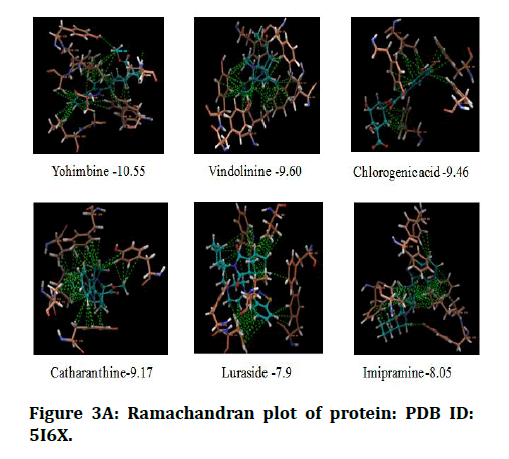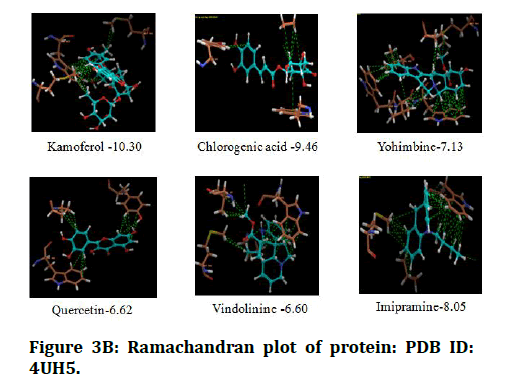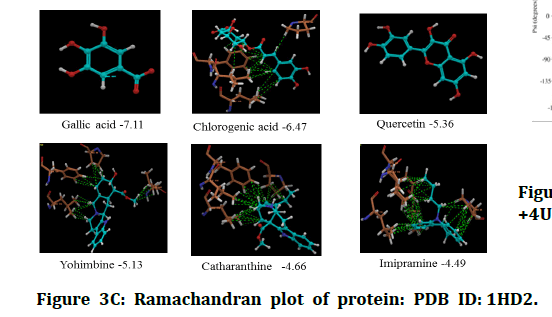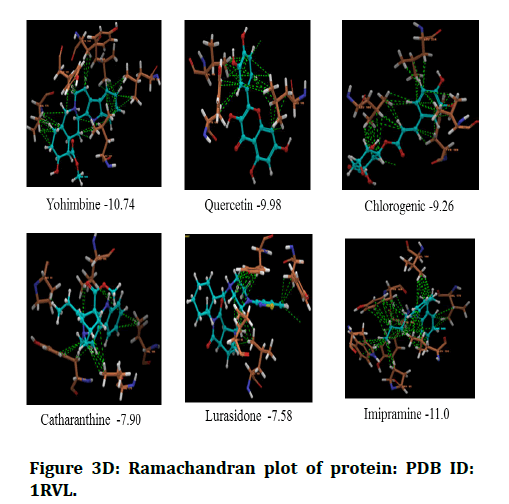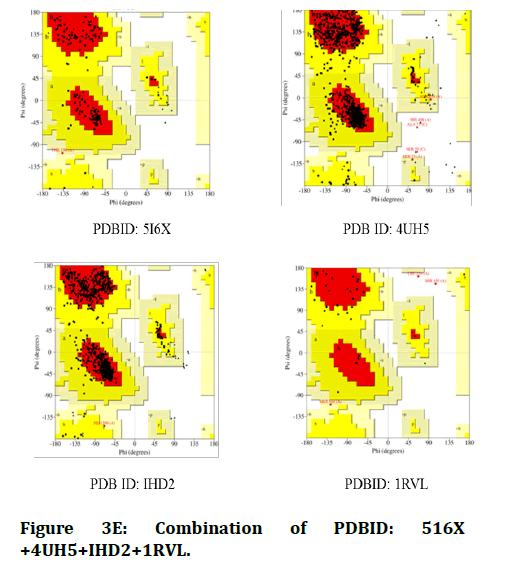Research - (2021) Volume 9, Issue 7
Therapeutic Targets for Depression Caused by Oxidative Stress
M Ganga Raju*, Ankitha G, and NVL Suvarchala Reddy V
*Correspondence: M Ganga Raju, Department of Pharmacology, Gokaraju Rangaraju College of Pharmacy, India, Email:
Abstract
Depression is a mood disorder that involves a persistent feeling of sadness and loss of interest which stops you doing your normal activities. The present study is focused on the evaluation of Leaves of Catharanthus roseus extract as antidepressant and anti-oxidant and to scientifically validate the claim by in silico docking studies of natural compounds present in the extract for their respective sites against selected proteins. The preliminary phytochemical investigation of methanolic extract of leaves of Catharanthus roseus revealed the presence of bioactive compounds of which phenolic acids, flavonoids, alkaloids, steroids, terpenoids, carbohydrates and tannins were the most prominent. In vivo evaluation of antidepressant activity of the extract of Catharanthus roseus was carried out by using Forced swim test and Tail suspension test. Imipramine was used as standard. The animal brains were subjected for histopathological studies and brain dopamine levels were also estimated in FST model. In vitro evaluation of antioxidant activity of the extract of Catharanthus roseus was carried out using Lipid peroxidation assay and Hydroxyl radical scavenging assay. Upon treatment with extract at 200 mg/kg. bd. wt, 400 mg/kg. bd. wt. & imipramine (5 mg/kg), the duration of immobility was found to be reduced when compared with the control group. Histopathological results clearly showed improvement in thickness of granule cell layer, increase in count of glial cells, no shrinkage of hippocampal volume and no visible atrophy was observed. This clearly shows that the extract possesses anti-depressant activity. Improved brain dopamine levels were observed in groups treated with extract and standard drug. The anti-oxidant results clearly showed the ability of the extract to scavenge the free radicals in both the assays. In the present study docking studies were performed for natural compounds present in the extract such as yohimbine, chlorogenic acid, catharanthine, kameferol, quercetin, vindolinine, gallic acid, serpentine, vindoline, lurasidone and standard drug imipramine against PDB ID: 5I6X, PDB ID: 4UH5, PDB ID: 1HD2, PDB ID: 1RVL using Schrödinger software. The statistical verification of the model was evaluated with PROCHEK; a structure verification program relies on Ramachandran plot which determines the quality of the predicted structures. The results revealed that yohimbine, chlorgenic acid, catharanthine, quercetin, vindolinine, lurasidone and standard drug imipramine had shown highest glide scores which indicates a stronger receptor-ligand binding affinity among the various phytochemical constituents present in the extract. From the above it is concluded that the extract possess anti-depressant and anti-oxidant activity.
Keywords
Imipramine, Catharanthus roseus, Docking studies, Ascorbic acid Schrödinger software
Introduction
Depression is a mood disorder causing a persistent feeling of sadness and loss of interest. It was previously known as melancholia and is now known as clinical depression, major depression, or simply depression. There are two distinct types of depressive syndrome, namely unipolar depression, in which the mood changes are always in the same direction, and bipolar affective disorder, in which depression alternates with mania [1]. The antidepressive pathways involve the monoamines noradrenaline (NA) and 5-hydroxytryptamine (5-HT), which acts on G protein-coupled receptors, and the brain-derived neurotrophic factor (BDNF), which acts on a kinase-linked receptor (TrkB), switching on genes that protect neurons against apoptosis and also promote neurogenesis [2]. Depression is a treatable mental illness by Support, Psychotherapy and antidepressants [1]. Standard drug used is imipramine i.e., tricyclic antidepressants that inhibit reuptake of norepinephrine and serotonin into presynaptic terminals. The brain with its high oxygen consumption and a lipid-rich environment is considered highly susceptible to oxidative stress or redox imbalances and has been proposed as a contributing factor in the pathogenesis of depression [3]. Catharanthus roseus is a species of flowering plant in the dogbane family Apocynaceae contain different active principles like alkaloids especially indole alkaloids, serpentine, ajmaline, catharanthine, catharanthinole, flavonoids, vindoline, vindolinine, leurosidine, vincristine, aminoacids and tannins [4,5]. An In silico analysis is performed with Schrodinger software which provide information about drug receptor interaction and Ramachandran plot is generated that can determine which torsional angles are permitted and can obtain insight into the structure of peptides.
Materials and Methods
Plant collection and drying
Leaves of Catharanthus roseus was collected from Medchal district, Telangana in the month of October and was identified and authenticated. The leaves were cleaned, dried under shade for about six days and coarsely powdered in a mixer grinder. The powdered material was stored or taken up for extraction process.
Preparation of the leaf extract
The powdered material of leaves of Catharanthus roseus were extracted with methanol by soxhlation technique. Soxhlet extraction is the process of continuous extraction in which the same solvent can be circulated through the extractor for several times. This process involves extraction followed by evaporation of the solvent. The vapours of the solvent are taken to a condenser and the condensed liquid is returned to the drug for continuous extraction.
Preliminary phytochemical screening
The extract was subjected to preliminary phytochemical screening to identify various phytoconstituents present in Catharanthus roseus.
Acute toxicity studies
sThe acute toxicity studies were carried out using OECD 425 guidelines. Present study was carried out in CPCSEA approved animal house of Gokaraju Rangaraju College of Pharmacy, Bachupally, Hyderabad, India (Reg.No. 1175/PO/ERe/S/08/CPCSEA).
Animal housing
The animals (mice and rats) were housed in poly acrylic cages with not more than six animals per cage, with 12 h light/12 h dark cycle. Animals have free access to standard diet and drinking water ad libitum. The animals were allowed to acclimatize the laboratory environment for a week before the start of the experiment. The care and maintenance of the animals were carried out as per the approved guidelines of the committee for the purpose of control and supervision of experiments on animals (CPCSEA).
In vivo methods for evaluation of antidepressant activity
In vivo evaluation of antidepressant activity of the methanolic leaf extract of Catharanthus roseus was carried out in following models.
- Forced swim test.
- Tail suspension test.
Forced swim test (FST)
The test is based on the observation that rats when forced to swim in a restricted space from which they cannot escape will eventually cease apparent attempts to escape and become immobile apart from the small movements necessary to keep their heads above water. The immobility was reduced by a variety of agents which are therapeutically effective in depression. Swiss albino rats of either sex weighing about 200-250 gm were selected for this study. Group I serves as control, Group II & III received MECR of 200 & 400 mg/kg for 5 days. Group IV received Imipramine at dose of 5 mg/kg for 5 days. The experimental session was of two trials. Conditioning trial on the 4th day and on 5th day of the treatment 2 h from the last dose, the Swiss albino rats were exposed to the cylinders again for 6 min (test session). The FST was performed by placing rats individually in water tank filled with water (22–25°C) to a depth of 30 cm, after 5 days of treatment using a modified form of the traditional method. The frequency and total duration of immobility was determined. Histopathological studies were carried in all the groups. Estimation of Dopamine levels in rat brain is done by dopamine assay [6].
Tail suspension test (TST)
Swiss Albino mice of either sex weighing about 25-30 gm were selected for this study. Immobility was induced by tail suspension according to the procedure of Steru and the animals were free to food and water [7]. All treatments were administered once daily for 5 days. On the 5th day, 2 h after the last dose, mice were suspended by tail individually through a paper adhesive tape, above the table top. Animals were allowed to suspend by their tail for 6 min and the duration of immobility was recorded. Mice were considered to be immobile only when suspended passively and completely motionless. Group I is control that receives normal saline. Group II & III receives 200 & 400 mg/kg for 5 days were as Group IV receives Imipramine at dose of 5 mg/kg for 5 days (Figure 1).
Figure 1: In vivo methods for evaluation of antidepressant activity.
In vitro antioxidant assay
In vitro evaluation of antioxidant activity of the methanolic leaf extract of Catharanthus roseus was carried out in following models.
- Lipid peroxidation assay.
- Hydroxyl radical scavenging assay.
Lipid peroxidation (LPO) assay
Lipid peroxidation can be defined as the oxidative deterioration of lipids. It is an autocatalytic process, which is a common consequence of cell death. This process may cause peroxidative tissue damage in inflammation, cancer and toxicity of xenobiotics and aging. It produces end products like 4-hydroxynonenal (HNE), malondialdehyde (MDA).
Procedure
Lipid peroxidation as evidenced by the formation of thiobarbituric acid reactive substances (TBARS) was estimated. LPO in this homogenate was determined by measuring the amounts of malondialdehyde (MDA) produced primarily. Tissue homogenate (0.2 ml), 0.2 ml of 8.1% TBA were added. The volume of the mixture was made upto 4 ml with distilled water and then heated at 95ºC on a water bath for 60 min. After incubation the tubes were cooled to room temperature and final volume was made to 5 ml in each tube. 5ml of butanol: pyridine (15:1) mixture was added and the contents were vortexed thoroughly for 2 min. After centrifugation at 3000 rpm for 10 minutes, the upper organic layer was taken and its optical density at 532nm against an appropriate blank without sample. Percentage inhibition of lipid peroxidation was calculated by using formula [8].
Percentage inhibition=Abscontrol–Abssample × 100/(Abscontrol)
Hydroxyl radical scavenging activity
Hydroxyl radical is one of the potent reactive oxygen species in the biological system that reacts with polyunsaturated fatty acid moieties of cell membrane phospholipids and causes damage to cell. The scavenging ability of hydroxyl radicals is measured by this method.
Procedure
The reaction mixture (1.0 ml) consist of 100 µL of 2-deoxy- D-ribose, 500 µL of the extract, 200 µL EDTA and 200 µM. FeCl3 (1:1 v/v), 100 µL of H2O2 (1.0 mm) and 100 µL ascorbic acid (1.0 mm) which is incubated at 37°C for 1 h. One millilitre of thiobarbituric acid (1%) and 1.0 mL of trichloroacetic acid (2.8%) are added and incubated at 100 °C for 20 min. After cooling, absorbance is measured at 532 nm, against a blank sample [9].
Percentage inhibition=Abscontrol–Abssample × 100 /(Abscontrol)
In silico modelling
Percentage inhibition=Abscontrol–Abssample × 100 /(Abscontrol)
In silico modelling
Molecular docking, an in silico analysis, is performed by Schrodinger software. Initially protein preparation is done by selecting PDB from RSCB site and active site is generated. With Chemsketch ligands are prepared. The docking analysis of the selected compounds with their respective PDB was carried out by Ligand fit of Maestro 9.1 (Schrodinger Software Inc.). The statistical verification of the model was evaluated with PROCHEK; a structure verification program relies on Ramachandran plot which determines the quality of the predicted structures.
Selection of proteins
Depression is a potentially life-threatening disorder that affects hundreds of millions of people all over the world. The main symptoms of depression are due to a functional deficiency of the brain monoaminergic transmitter’s norepinephrine (NE), 5-HT, and/or dopamine (DA). The first-generation antidepressants, the tricyclic antidepressants (TCAs) and MAO inhibitors (MAOIs), increase the concentrations of 5-HT and/or NE and are effective in alleviating the symptoms of depression. Most antidepressant drugs like imipramine increase the concentration of 5-HT in the extracellular brain space by preventing its reuptake. Hence in the present study a 5-HT transporter protein with PDB ID: 5I6X is selected and screened against the active constituents present in the extract. Nitric oxide is also involved in the neurobiology of major depression. More importantly, nNOS deletion or intra hippocampal nNOS inhibition blocked the corticosterone-induced behavioural modifications in the chronic mild stress model, thus indicating that hippocampal nNOS is necessary for the role of glucocorticoids in mediating depressive behaviours [10]. Evidence indicates that reducing NO synthesis/levels by blocking NOS enzymes in the brain can exert antidepressant-like effects [11]. In this context, we docked the isolated compounds against the nNOS enzyme inhibitor, PDB ID: 4UH5 as a potential target for antidepressant therapy. The primary antioxidant defense system involves the coordinated effects of some enzymes, such as SOD, catalase (CAT), GPx, and GR, which have consistently been studied in individuals with depression [12]. Using mice subjected to stress [13], found a reduction in the activity of CAT and GR, especially in the hippocampus, as well as GR in the cerebral cortex, indicating a change in the antioxidant defense system in the nervous system of these animals. A reduction in CAT activity is associated with a large amount of H2O2 available to react with transcription metals and generate the most harmful radical (hydroxyl), resulting in an increase in lipid peroxidation and subsequent neuron damage [14]. Major depression has been associated with lowered concentrations of several endogenous antioxidant compounds, such as vitamin E, zinc and coenzyme Q10 or enzymes, such as glutathione peroxidase, and with an impairment of the total antioxidant status. These observations introduce new potential targets for the development of therapeutic interventions. In this context, we docked the compounds against the anti-oxidant promoter, PDB ID: 1HD2 and anti-oxidant Co-Q10 promoter, PDB ID: 1RVL as a potential target for anti-oxidant activity.
Statistical analysis
Values are expressed as Mean ± SEM, (n=6). Statistical analysis was performed by using ANOVA followed by Dunnet’s test by comparing with control and standard. Significant values were expressed as p < 0.001 and p < 0.005.
Results
Methanolic extract of leaves of Catharanthus roseus was explored for its in vivo antidepressant activity using suitable rodent models. The antioxidant activity was also investigated in the present study. All the results obtained in the study were included below.
Preparation of methanolic extract of leaves of Catharanthus roseus
The methanolic extract of leaves of Catharanthus roseus was prepared by soxhlation technique. The percentage yield of methanolic extract was calculated by using the following formula.

Histopathology of rat brain
In control group, Hippocampus region, granule cell layer, volume of hippocampus and glial cell number are normal and no atrophy was observed. In Disease group, the thick granule cell layer was found to be thinner, hippocampus region is reduced and hippocampus atrophy was seen. Number of glial cells was found to be reduced. But in extract treated groups, the thickness of granule cell layer marginally increased. Hippocampal volume and glial cell number increased and Hippocampal atrophy was found to be minimal. Standard imipramine group resulted in high thickness of granule cell layer. No visible atrophy and no shrinkage of hippocampal volume were observed. Increase in glial cell count was prominent (Figure 2).
Figure 2: Histopathology of Hippocampus of rat in Forced swim test model.
Estimation of dopamine levels in rat brain
The results obtained in in vitro antidepressant assay are tabulated in the table 2. The dopamine levels in the groups treated with MECR and standard levodopa were found to be more when compared with the control (Table 2).
Tail suspension test (TST)
The results obtained in tail suspension test are tabulated in the table 3. Tail suspension test has induced the depression in different group of animal and duration of immobility is recorded as an indicative of its depressant effect. From the results, it is clear that duration of immobility in control group was found to be higher. But in groups treated with the MECR and standard (imipramine 5 mg/kg, i.p) the duration of immobility was found to be reduced.
In vitro antioxidant assay
The methanolic extract of leaves of Catharanthus roseus was subjected to in vitro antioxidant activity. In vitro antioxidant activity was performed using.
- Forced swim test.
- Tail suspension test.
Forced swim test
Forced swim test has induced the depression in different groups of animals and duration of immobility is recorded as an indicative of its depressant effect in table 1. In groups treated with the MECR and standard (imipramine 5 mg/kg, i.p) the duration of immobility was found to be reduced when compared to the normal control group clearly indicating their antidepressant activity (Table 1).
Table 1: Effect of MECR on duration of immobility in forced swim test.
| Groups | Treatment | Duration of immobility(sec) |
|---|---|---|
| I | Saline water | 159±0.65 |
| II | MECR (200 mg/kg, p.o) | 125.33±0.99**,a |
| III | MECR (400 mg/kg, p.o) | 97.66±0.69**,ns |
| IV | Imipramine (5 mg/kg, i.p) | 98.5±0.99** |
Values were expressed as Mean ± SEM (n=6). Statistical analysis was performed by using ANOVA followed by Dunnett’s test. Results were compared with control (** p<0.001) and standard ( ap<0.05, ns=non-significant).
Histopathology of rat brain
In control group, Hippocampus region, granule cell layer, volume of hippocampus and glial cell number are normal and no atrophy was observed. In Disease group, the thick granule cell layer was found to be thinner, hippocampus region is reduced and hippocampus atrophy was seen. Number of glial cells was found to be reduced. But in extract treated groups, the thickness of granule cell layer marginally increased. Hippocampal volume and glial cell number increased and Hippocampal atrophy was found to be minimal. Standard imipramine group resulted in high thickness of granule cell layer. No visible atrophy and no shrinkage of hippocampal volume were observed. Increase in glial cell count was prominent (Figure 2).
Estimation of dopamine levels in rat brain
The results obtained in in vitro antidepressant assay are tabulated in the table 2. The dopamine levels in the groups treated with MECR and standard levodopa were found to be more when compared with the control (Table 2).
Table 2: Antidepressant activity of MECR by Estimation of dopamine levels in rat brain.
| Groups | Treatment | Brain dopamine levels (ng/ml) |
|---|---|---|
| I | Control | 311 |
| II | MECR (200 mg/kg) | 367 |
| III | MECR (400 mg/kg) | 428 |
| IV | Levodopa (20 ng/kg) | 500.8 |
Tail suspension test (TST)
The results obtained in tail suspension test are tabulated in the table 3. Tail suspension test has induced the depression in different group of animal and duration of immobility is recorded as an indicative of its depressant effect. From the results, it is clear that duration of immobility in control group was found to be higher. But in groups treated with the MECR and standard (imipramine 5 mg/kg, i.p) the duration of immobility was found to be reduced.
Table 3: Effect of MECR on duration of immobility in tail suspension test.
| Groups | Treatment | Duration of immobility (sec) |
|---|---|---|
| I | Saline water | 121±0.97 |
| II | MECR (200 mg/kg, p.o) | 98.66±0.76**,aa |
| III | MECR (400 mg/kg, p.o) | 88.33±0.76**,aa |
| IV | Imipramine (5 mg/kg, i.p) | 75.66±0.96** |
Values were expressed as Mean ± SEM (n=6). Statistical analysis was performed by using ANOVA followed by Dunnett’s test. Results were compared with control (**p<0.001) and standard (aa p<0.001).
In vitro antioxidant assay
The methanolic extract of leaves of Catharanthus roseus was subjected to in vitro antioxidant activity. In vitro anti-oxidant activity was performed using.
- Lipid peroxidation assay.
- Hydroxyl radical scavenging assay.
In vitro antioxidant activity was performed using lipid peroxidation assay. The results were expressed in Table 4. In lipid peroxidation assay, MECR was tested at different concentrations like 10, 20, 30, 40, and 50 μg/ml and percentage inhibition and IC50 values was found to be 37 μg/ml which is compared with standard ascorbic acid having IC50 value of 35 μg/ml respectively.
Table 4: Lipid peroxidation assay of methanolic leaf extract of Catharanthus roseus.
| S.no | Compounds | Concentration (µg/ml) | % inhibition | Ic50 values |
|---|---|---|---|---|
| 1 | MECR | 10 | 19.03±0.25 | 37 |
| 20 | 29.70±0.42 | |||
| 30 | 42.20±0.42 | |||
| 40 | 54.40±0.73 | |||
| 50 | 65.4±0.42 | |||
| 2 | Ascorbic acid | 10 | 21.1±0.84 | 35 |
| 20 | 33±0.73 | |||
| 30 | 45.2±0.42 | |||
| 40 | 56.81±0.4 | |||
| 50 | 68.11±0.44 |
Hydroxyl radical scavenging assay
In hydroxyl radical scavenging assay, MECR was tested at different concentrations like 10, 20, 30, 40, and 50 μg/ml and percentage inhibition and IC50 values are tabulated in the Table 5. The IC50 value for MECR was found to be 35 μg/ml which is compared with standard ascorbic acid having IC50 value of 28 μg/ml respectively.
Table 5: Hydroxyl radical scavenging assay of methanolic leaf extract of Catharanthus roseus.
| S.no | Compounds | Concentration (µg/ml) | % inhibition | Ic50 values |
|---|---|---|---|---|
| 1 | MECR | 10 | 20.8±0.50 | 35 |
| 20 | 32.48±1.20 | |||
| 30 | 42.76±1.82 | |||
| 40 | 57.5±1.96 | |||
| 50 | 59.96±0.69 | |||
| 2 | Ascorbic acid | 10 | 23.83±0.37 | 28 |
| 20 | 38.3±0.36 | |||
| 30 | 51.33±0.37 | |||
| 40 | 59.4±0.42 | |||
| 50 | 66.9±0.43 |
Insilico modelling
Molecular docking
Molecular docking is mentioned in Table 6. Figure 3A to 3E and Table explains the Ramachandran plot of protein.
Table 6: Glidescore of proteins by molecular docking (Schrodinger software).
| Constituents | Glide score (KcaL/moL) | |||
|---|---|---|---|---|
| 5I6X | 4UH5 | 1HD2 | 1RVL | |
| Yohimbine | -10.55 | -7.13 | -5.13 | -10.74 |
| Chlorogenic acid | -9.46 | -9.35 | -6.47 | -9.26 |
| Catharanthine | -9.17 | -4.78 | -4.66 | -7.9 |
| Kameferol | -- | -10.3 | -- | -- |
| Quercetin | -7.73 | -6.62 | -5.36 | -9.98 |
| Vindolinine | -9.6 | -6.6 | -4.42 | -7.03 |
| Gallic acid | -6.75 | -6.43 | -7.11 | -6.63 |
| Serpentine | -7.72 | -4.32 | -3.44 | -7.03 |
| Vindoline | -4.39 | -- | -2.95 | -6.22 |
| Lurasidone | -7.93 | -5.37 | -3.95 | -7.58 |
| Imipramine | -8.05 | -4.7 | -4.49 | -11.07 |
Table 7: Ramachandran plot statistics by procheck.
| Protein | Favoured regions (%) | Additional allowed regions (%) | Generously allowed regions (%) | Disallowed regions (%) |
|---|---|---|---|---|
| 5I6X | 89.2 | 10.2 | 0.2 | 0.4 |
| 4UH5 | 90.2 | 9.8 | 0 | 0 |
| 1HD2 | 87.2 | 11.5 | 0.08 | 0 |
| IRVL | 60.6 | 30.3 | 3 | 6.1 |
Figure 3A: Ramachandran plot of protein: PDB ID: 5I6X.
Figure 3B: Ramachandran plot of protein: PDB ID: 4UH5.
Figure 3C: Ramachandran plot of protein: PDB ID: 1HD2.
Figure 3D: Ramachandran plot of protein: PDB ID: 1RVL.
Figure 3E: Combination of PDBID: 516X +4UH5+IHD2+1RVL.
Discussion
Anti-depressant activity
Depression or major depressive disorder is a mental health condition marked by an overwhelming feeling of sadness, isolation and despair that affects how a person thinks, feels and functions. The Forced swim test is based on the assumption that when placing an animal in a container filled with water, it will first make efforts to escape but eventually will exhibit immobility that may be considered to reflect a measure of behavioural despair. The decrease in duration of immobility is considered to be a good predictive value in the evaluation of potential antidepressant agents [15]. The Tail suspension test based on the fact that animals subjected to the short term, inescapable stress of being suspended by their tail, will develop an immobile posture. Various antidepressants reverse the immobility and promote the occurrence of escape related behaviour [16].
The preliminary phytochemical investigation of methanolic extract of leaves of Catharanthus roseus revealed the presence of alkaloids, flavonoids, phenolic acids, steroids and tannins. Alkaloids bearing the indole moiety have been described to own affinity toward different serotonin receptors. The structural similarity of indole alkaloids to endogenous neurotransmitters like serotonin has led investigators to predict the potential antidepressant activity of these molecules [17]. Flavonoids were known to act by lowering the corticotrophin releasing hormone showing antidepressant activity. Imipramine was the first tricyclic antidepressant, a class named for its three ring molecular structure. It works by inhibiting the reuptake of certain neurotransmitters in the brain including acetylcholine, dopamine, norepinephrine and serotonin.
Anti-oxidant activity
Lipid peroxidation is a self-propagating chain-reaction, the initial oxidation of only few lipid molecules can result in significant tissue damage [18]. The reducing property of MECR indicates that they can be used as electron donors which reduced the oxidized intermediates of lipid peroxidation process. Alkaloids inhibit Fe2+-induced lipid peroxidation of biological membrane and protects against decrease in membrane compartment due to Fe2+-induced lipid peroxidation. Flavonoids, Quercetin and its glucosides have been found to be very effective in preventing lipid peroxidation which is also an indication of their antioxidant activity. In addition to quercetin, there are other flavonoids such as myricetin, quercetrin and rutin which help to inhibit the production of superoxide radicals [19].
Hydroxyl radical can be formed by the Fenton reaction in the presence of reduced transition metals (such as Fe2+) and H2O2, which is known to be the most reactive of all the reduced forms of di-oxygen and is thought to initiate cell damage in vivo. The hydroxyl radical is an extremely reactive free radical formed in biological system and has been implicated as a highly damaging species, capable of damaging almost every molecule found in living cell [20]. Alkaloids scavenged hydroxyl radical by reacting with hydroxyl radical and prevents the DNA damage as reported by [21]. Polyphenolic compounds including flavonoids are known as powerful antioxidants due to their hydroxyl groups and radical scavenging activities [22]. Kaempferol (flavonoid) shows reducing property by acting as the chelators of iron ions and thereby preventing the formation of radical as reported by [23]. Tannins have the ability to chelate metal ions such as Fe (II) and interfere with one of the reaction steps in the Fenton reaction and thereby retard oxidation act via the inhibition of cyclooxygenase [24]. The scavenging activity of MECR might be due to presence of above constituents present in leaves of Catharanthus roseus.
Molecular docking
Molecular docking continues to holds great promise in the field of computer based drug design which screens small molecules by orienting and scoring them in the binding site of a protein. The docking analysis of isolated compounds from methanolic extract of Catharanthus roseus. and standard drug like Imipramine were carried out using Schrödinger software. The various constituents identified in the plant extract are yohimbine, chlorgenic acid, catharanthine, kameferol, quercetin, vindolinine, gallic acid, serpentine, vindoline, lurasidone and standard drug Imipramine were subjected to docking against PDB ID: 5I6X, PDB ID: 4UH5, PDB ID: 1HD2, PDB ID: 1RVL. The proteins identified namely PDB ID: 5I6X, PDB ID: 4UH5, PDB ID: 1HD2, PDB ID: 1RVL are modelled and the qualities of the 3D model were evaluated using the PROCHECK program and assessed using the Ramachandran plot.
The highest glide scores were observed with yohimbine, chlorgenic acid, catharanthine, and vindolinine against PDB ID: 5I6X, kameferol, chlorogenic acid, yohimbine, vindolinine against PDB ID: 4UH5, gallic acid, chlorgenic acid, quercetin, yohimbine against PDB ID: IHD2 and yohimbine, quercetin, chlorogenic acid, catharanthine against PDB ID: 1RVL
The glide scores of the yohimbine, chlorogenic acid, vindolinine, quercetin, Kameferol, catharanthine were found to be similar with the glide score of standard drug Imipramine stating that the compounds have same affinity to bind to the proteins. These results clearly indicate that the chemical constituents mentioned above might have shown similar mechanism to that of the standard drug Imipramine in reducing depression. It is evident from the Ramachandran plot that predicted models have most favorable regions, additionally allowed regions, generally allowed regions and disallowed regions. Such a percentage distribution of the protein residues determined by Ramachandran plot shows that the predicted models are of good quality. According to Ramachandran plot a good quality model would be expected to have over 90 % in the most favoured region. Proteins like 5I6X, 4UH5, and IHD2, showed almost 90% most favourable regions which clearly indicate that the selected models in the present study are of good quality.
Conclusion
The methanolic leaf extract of Catharanthus roseus was possesses antidepressant and antioxidant activities. Further studies are needed to be carried out to isolate individual phytochemical constituents of the extract and to establish the exact mechanism for its antidepressant and anti-oxidant activities.
References
- Rang HP, Dale MM. Pharmacology, 8th edition, Philadelphia: Elsevier, 2016; 467-588.
- Charney DS, Manji HK. Life stress, genes and depression multiple pathways lead to increased risk and new oppurtunities for intervention. Sci STKE 2004; 225:re5.
- Samina S. Oxidative stress and psychological disorders. Current Neuropharmacol 2014; 12:140–147.
- Rangari V. Pharmacognosy & phytochemistry. 1st Ed. Nashik, Maharashtra: Career Publications 2009.
- Kabesh K, Senthilkumar P, Ragunathan R, et al. Phytochemical analysis of catharanthus roseus plant extract and its antimicrobial activity. Int J Pure Applied Biosci 2015; 3:162-172.
- Sravani K, Sivarama Krishna K. Antidepressant and Antioxidant activity of methanolic extract of Asparagus racemosus seeds. Asian J Pharma Clin Res 2013; 6:102-107.
- Steru L, Chermat R, Thierry B, et al. The tail suspension test: A new method for screening antidepressants in mice. Psychopharmacology 1985; 85:367-370.
- Ohkawa H, Ohishi N, Yagi K. Assay for lipid peroxides in animal tissues by thiobarbituric acid reaction. Anal Biochem 1979; 95:351-358.
- Raju MG, Kumaraswamy K. Effect of methanolic extract of Cajanus cajan on blood lipids and oxidative stress in HFD and fructose induced hyperlipidemic rats. Eur J Pharm Med Res 2018; 5:388-393.
- Qi-Gang Zhou, Li-Juan Zhu, Chen Chen, et al. Hippocampal neuronal nitric oxide synthase mediates the stress-related depressive behaviors of glucocorticoids by downregulating glucocorticoid receptor. J Neurosci 2011; 31:7579-7590.
- Manikandan P, Nagini S. Cytochrome P450 structure, function and clinical significance: A review. Current Drug Targets 2017; 19:38–54.
- Ng F, Berk M, Dean O, et al. Oxidative stress in psychiatric disorders: evidence base and therapeutic implications. Int J Neuropsychopharmacol 2008; 11:851–876.
- Moretti M, Colla A, de Oliveira Balen G, et al. Ascorbic acid treatment, similarly to fluoxetine, reverses depressive‐like behavior and brain oxidative damage induced by chronic unpredictable stress. J Psychiatr Res 2012; 46: 331–340.
- Meister A, Anderson ME. Glutathione. Annual Rev Biochem 1983; 52:711–760.
- Vinod SP, Shivakumar H. Antidepressant like effects of Acorus calamus in forced swimming test and tail suspension test in mice. Asian Pacific J Tropical Biomed 2011; 1:S17-S19.
- Cryan JF, Mombereau C, Vassout A. The tail suspension test as a model for assessing antidepressant activity: Review of pharmacological and genetic studies in mice. Neurosci Biobehav Rev 2005; 29:571-625.
- Kochanowska-karamyan AJ, Hamann MT. Marine indole alkaloids: Potential new drug leads for the control of depression and anxiety. Chem Rev 2010; 110:4489-4497.
- Hussein RH, Khalifa FK. The protective role of ellagi tannins flavonoids pretreatment against N-nitrosodiethylamine induced-hepatocellular carcinoma. Saudi J Biol Sci 2014; 21:589-596.
- Panche AN, Diwan AD, Chandra SR. Flavonoids: An overview. J Nutr Sci 2016; 5:e47.
- Jelveh S, Kaspler P, Bhopal N, et al. Investigations of antioxidant mediated protection and mitigation of radiation-induced DNA damage and lipid p-eroxidation in murine skin. International J Radiation Biol 2013; 89:618-627.
- Herraiz T, Galisteo J. Hydroxyl radical reactions and the radical scavenging activity by beta carboline alkaloids. Food Chem 2015; 1:640-649.
- Chang E, Kim YC. Lipid peroxidation and antioxidant activities of the aqueous rhizome extract of Rheum officinale. J Food Quality 2018; 2018:1-7.
- Gandhimathi C, Sathiyasekaran WC, Perumai T, et al. Nutritional evaluation in vivo free radical scavenging and anti-inflammatory effects of Gisekia pharnaceoides and identification of kaempferol as a nutraceutical agent. Bri Biotechnol J 2011; 1:113-135.
- Amarowicz R. Tannins: The new natural antioxidants? Eur J Lipid Sci Technol 2007; 109:549-551.
Author Info
M Ganga Raju*, Ankitha G, and NVL Suvarchala Reddy V
Department of Pharmacology, Gokaraju Rangaraju College of Pharmacy, Bachupally, Hyderabad, 500090, Telangana, IndiaCitation: M Ganga Raju, Ankitha G, NVL Suvarchala Reddy V,Therapeutic Targets for Depression Caused BY Oxidative Stress, J Res Med Dent Sci, 2021, 9(7): 173-181
Received: 12-Apr-2021 Accepted: 12-Jul-2021

